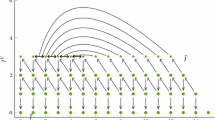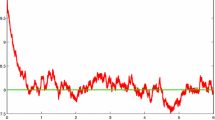Abstract
We consider the classical deterministic susceptible-infective-susceptible epidemic model, where the infection and recovery rates depend on a background environmental process that is modeled by a continuous time Markov chain. This framework is able to capture several important characteristics that appear in the evolution of real epidemics in large populations, such as seasonality effects and environmental influences. We propose computational approaches for the determination of various distributions that quantify the evolution of the number of infectives in the population.









Similar content being viewed by others
References
Allen LJS (2007) An introduction to mathematical biology. Pearson Prentice Hall, New Jersey
Anderson DR (1975) Optimal exploitation strategies for an animal population in a Markovian environment: a theory and an example. Ecology 56:1281–1297
Artalejo JR, Economou A, Lopez-Herrero MJ (2010a) The maximum number of infected individuals in SIS epidemic models: computational techniques and quasi-stationary distributions. J Comput Appl Math 233:2563–2574
Artalejo JR, Economou A, Lopez-Herrero MJ (2010b) On the number of recovered individuals in the SIS and SIR stochastic epidemic models. Math Biosci 228:45–55
Artalejo JR, Economou A, Lopez-Herrero MJ (2013) Stochastic epidemic models with random environment: quasi-stationarity, extinction and final size. J Math Biol 67:799–831
Bacaër N, Ed-Darraz A (2014) On linear birth-and-death processes in a random environment. J Math Biol 69:73–90
Bacaër N, Khaladi M (2013) On the basic reproduction number in a random environment. J Math Biol 67:1729–1739
Britton T, Lindholm M (2009) The early stage behavior of a stochastic SIR epidemic with term-time forcing. J Appl Probab 46:975–992
Caswell H, Cohen JE (1995) Red, white and blue: environmental variance spectra and coexistence in metapopulations. J Theor Biol 176:301–316
De Bruijn NG (1981) Asymptotic methods in analysis. Dover Publications, New York
El-Taha M, Stidham Jr S (1999) Sample-path analysis of queueing systems. Kluwer Academic Publishers, Boston
Gray A, Greenhalgh D, Mao X, Pan J (2012) The SIS epidemic model with Markovian switching. J Math Anal Appl 394:496–516
Hernandez-Suarez C, Rabinovich J, Hernandez K (2012) The long-run distribution of births across environments under environmental stochasticity and its use in the calculation of unconditional life-history parameters. Theor Popul Biol 82:264–274
Hethcote HW (1976) Qualitative analyses of communicable disease models. Math Biosci 28:335–356
Jewel NP (2004) Statistics for epidemiology. Chapman & Hall/CRC, Boca Raton
Keeling MJ, Rohani P (2008) Modeling infectious diseases in human and animals. Princeton University Press, New Jersey
Kulkarni VG (2010) Modeling and analysis of stochastic systems, 2nd edn. CRC Press, Boca Raton
Lamb KE, Greenhalgh D, Robertson C (2010) A simple mathematical model for genetic effects in pneumonococcal carriage and transmission. J Comput Appl Math 235:1812–1818
Mikolajczyk R (2010) Methods and concepts of epidemiology. In: Kramer et al (eds) Modern infectious disease epidemiology. Statistics for biology and health. Springer, Berlin, pp 193-208
Nåsell I (2001) Extinction and quasi-stationarity in the Verhulst logistic model. J Theor Biol 211:11–27
Padilla DK, Adolph SC (1996) Plastic inducible morphologies are not always adaptive: the importance of time delays in a stochastic environment. Evol Ecol 10:105–117
Sigman K (1995) Stationary marked point processes. Chapman & Hall, Boca Raton
Slatkin M (1978) The dynamics of a population in a Markovian environment. Ecology 59:249–256
Takeuchi Y, Du NH, Hieu NT, Sato K (2006) Evolution of predator–prey systems described by a Lotka–Volterra equation under random environment. J Math Anal Appl 323:938–957
Acknowledgments
Financial support for this work was provided by the Government of Spain (Ministry of Economy and Competitiveness) and the European Commission through the Project MTM-2011-23864.
Author information
Authors and Affiliations
Corresponding author
Rights and permissions
About this article
Cite this article
Economou, A., Lopez-Herrero, M.J. The deterministic SIS epidemic model in a Markovian random environment. J. Math. Biol. 73, 91–121 (2016). https://doi.org/10.1007/s00285-015-0943-7
Received:
Revised:
Published:
Issue Date:
DOI: https://doi.org/10.1007/s00285-015-0943-7
Keywords
- SIS epidemic model
- Random environment
- Number of infectives
- Markov chain
- Markovian switching
- Color noise
- Telegraph noise
- Steady-state distribution
- Embedded distribution




